Influence of Crystallite Size on the Magnetic Order in Semiconducting ZnCr2Se4 Nanoparticles
Abstract
:1. Introduction
2. Materials and Methods
3. Results and Discussion
3.1. Structural Characteristics
3.2. Electrical Properties
3.3. Magnetic Properties
3.4. Specific Heat
4. Conclusions
Author Contributions
Funding
Acknowledgments
Conflicts of Interest
References
- Snyder, G.J.; Caillat, T.; Fleurial, J.P. Thermoelectric properties of chalcogenides with the spinel structure. Mater. Res. Innov. 2001, 5, 67–73. [Google Scholar] [CrossRef]
- Groń, T.; Krajewski, A.; Duda, H.; Urbanowicz, P. Influence of nonstoichiometry on the lattice excitations in the ZnxCuyCrzSe4 p-type spinel ferromagnetic conductors. Physica B 2006, 373, 245–252. [Google Scholar] [CrossRef]
- Mazur, S.; Groń, T.; Jendrzejewska, I. Influence of spin arrangement on thermopower in ZnxCuyCrzSe4 spinels. J. Alloy Compd. 2009, 480, 19–22. [Google Scholar] [CrossRef]
- Shannon, R.D. Revised effective ionic radii and systematic studies of interatomic distances in halides and chalcogenides. Acta Cryst. 1976, A 32, 751–767. [Google Scholar] [CrossRef]
- Philipsborn, H. Chalcogenide spinels and alternative structures. Z. Kristallogr. Cryst. Mater. 1971, 133, 464–472. [Google Scholar] [CrossRef]
- Plumier, R. Étude par diffraction de neutrons de l’antiferromagnétisme hélicoïdal du spinelle ZnCr2Se4 en présence d’un champ magnétique. J. Phys. (Paris) 1966, 27, 213–219. [Google Scholar] [CrossRef]
- Lotgering, F.K. Proceedings of the International Conference on Magnetism: Held at Nottingham, Sept. 1964; Institute of Physics (IOP): London/Bristol, UK, 1965; p. 533. [Google Scholar]
- Kleinberger, R.; Kouchkovsky, R. Étude radiocristallographique á basse température du spinelle ZnCr2Se4. Phys. Solides. Comp. Rend. Acad. Sci. (Paris) 1966, 262, 628–630. [Google Scholar]
- Hemberger, J.; von Nidda, H.A.K.; Tsurkan, V.; Loidl, A. Large magnetostriction and negative thermal expansion in the frustrated antiferromagnet ZnCr2Se4. Phys. Rev. Lett. 2007, 98, 147203. [Google Scholar] [CrossRef]
- Malicka, E.; Waśkowska, A.; Mydlarz, T.; Kaczorowski, D. Structural and magnetic properties of single—Crystalline spinel systems ZnCr2−xAlxSe4 (x = 0.15 and 0.23). J. Alloy Compd. 2007, 440, 1–5. [Google Scholar] [CrossRef]
- Malicka, E.; Groń, T.; Ślebarski, A.; Gągor, A.; Pacyna, A.W.; Sitko, R.; Goraus, J.; Mydlarz, T.; Heimann, J. Specific heat and magnetic susceptibility of single-crystalline ZnCr2Se4 spinels doped with Ga, In and Ce. Mater. Chem. Phys. 2011, 131, 142–150. [Google Scholar] [CrossRef]
- Malicka, E.; Waśkowska, A.; Heimann, J.; Mydlarz, T.; Sitko, R.; Kaczorowski, D. Structural and magnetic properties of Zn1−xSbxCr2−x/3Se4 (x = 0.11, 0.16 and 0.20) single crystals. J. Solid State Chem. 2008, 181, 1970–1976. [Google Scholar] [CrossRef]
- Jendrzejewska, I.; Zajdel, P.; Goryczka, T.; Goraus, J.; Kita, A.; Mydlarz, T. Influence of covalency and anion polarization on magnetic and electronic properties of ZnCr2−x NixSe4. J. Alloy Compd. 2012, 520, 153–157. [Google Scholar] [CrossRef]
- Jendrzejewska, I.; Groń, T.; Kusz, J.; Żelechower, M.; Maciążek, E.; Ślebarski, A.; Fijałkowski, M. Spin-glass-like behaviour in tin doped ZnCr2Se4 single crystals. J. Alloys Compd. 2015, 635, 238–244. [Google Scholar] [CrossRef]
- Maciążek, E.; Malicka, E.; Karolus, M.; Panek, J.; Stokłosa, Z.; Groń, T.; Gudwański, A.; Sawicki, B. Magnetic characteristics of CuCr2S4 nanospinels obtained by mechanical alloying and heat treatment. IEEE Trans. Magn. 2017, 53, 2400205. [Google Scholar]
- Williamson, G.K.; Hall, W.H. X-ray line broadening from filed aluminium and wolfram. Acta Metall. 1953, 1, 22–31. [Google Scholar] [CrossRef]
- Young, R.A. The Rietveld Method; Oxford University Press: Oxford, UK, 1993; Chapter 6. [Google Scholar]
- McCusker, L.B.; von Dreele, R.B.; Cox, D.E.; Louer, D.; Scardi, P. Rietveld refinement guidelines. J. Appl. Crystallogr. 1999, 32, 36–50. [Google Scholar] [CrossRef]
- Karolus, M.; Łągiewka, E. Crystallite size and lattice strain in nanocrystalline Ni-Mo alloys studied by Rietveld Refinement. J. Alloy Compd. 2004, 367, 235–238. [Google Scholar] [CrossRef]
- Karolus, M. Applications of Rietveld refinement in Fe-B-Nb alloy structure studies. J. Mater. Process. Technol. 2006, 175, 246–250. [Google Scholar] [CrossRef]
- Groń, T.; Krok-Kowalski, J.; Duda, H.; Mydlarz, T.; Gilewski, A.; Walczak, J.; Filipek, E.; Bärner, K. Metamagnetism in the Cr2V4−xMoxO13+0.5x solid solutions. Phys. Rev. B 1995, 51, 16021–16024. [Google Scholar] [CrossRef]
- Krok-Kowalski, J.; Groń, T.; Warczewski, J.; Mydlarz, T.; Okońska-Kozłowska, I. Ferrimagnetism and metamagnetism in Cd1−xCuxCr2S4 spinels. J. Magn. Magn. Mater. 1997, 168, 129–138. [Google Scholar] [CrossRef]
- Groń, T.; Pacyna, A.W.; Malicka, E. Influence of temperature independent contribution of magnetic susceptibility on the Curie-Weiss law. Solid State Phenom. 2011, 170, 213–218. [Google Scholar] [CrossRef]
- Holland, W.E.; Brown, H.A. Application of the Weiss molecular field theory to the B-site spinel. Phys. Status Solidi A 1972, 10, 249–253. [Google Scholar] [CrossRef]
- Derrida, B. Random-energy model: Limit of a family of disordered models. Phys. Rev. Lett. 1980, 45, 79–82. [Google Scholar] [CrossRef]
- Derrida, B. Random-energy model: An exactly solvable model of disordered systems. Phys. Rev. B 1981, 24, 2613–2626. [Google Scholar] [CrossRef]
- Binder, K.; Young, A.P. Spin glasses: Experimental facts, theoretical concepts, and open questions. Rev. Mod. Phys. 1986, 58, 801–976. [Google Scholar] [CrossRef]
- Groń, T.; Duda, H.; Warczewski, J. Influence of the valence of the substituted cations on the electrical properties of the magnetically modulated spinels Zn1−xAxCr2Se4 (A = Cu, Ga2/3). Phys. Rev. B 1990, 41, 12424–12431. [Google Scholar] [CrossRef] [PubMed]
- Groń, T. Influence of vacancies and mixed valence on the transport processes in solid solutions with the spinel structure. Philos. Mag. B 1994, 70, 121–132. [Google Scholar] [CrossRef]
- Tholence, J.L. On the frequency dependence of the transition temperature in spin glasses. Solid State Commun. 1980, 35, 113–117. [Google Scholar] [CrossRef]
- Duda, H.; Maciążek, E.; Groń, T.; Mazur, S.; Pacyna, A.W.; Waśkowska, A.; Mydlarz, T.; Gilewski, A. Spin-glass-like behaviour in single-crystalline Cu0.44In0.48Cr1.95Se4. Phys. Rev. B 2008, 77, 035207-8. [Google Scholar] [CrossRef]
- Yi, J.B.; Ding, J.; Feng, Y.P.; Peng, G.W.; Chow, G.M.; Kawazoe, Y.; Liu, B.H.; Yin, J.H.; Thongmee, S. Size-dependent magnetism and spin-glass behavior of amorphous NiO bulk, clusters, and nanocrystals: Experiments and first-principles calculations. Phys. Rev. B 2007, 76, 224402. [Google Scholar] [CrossRef]
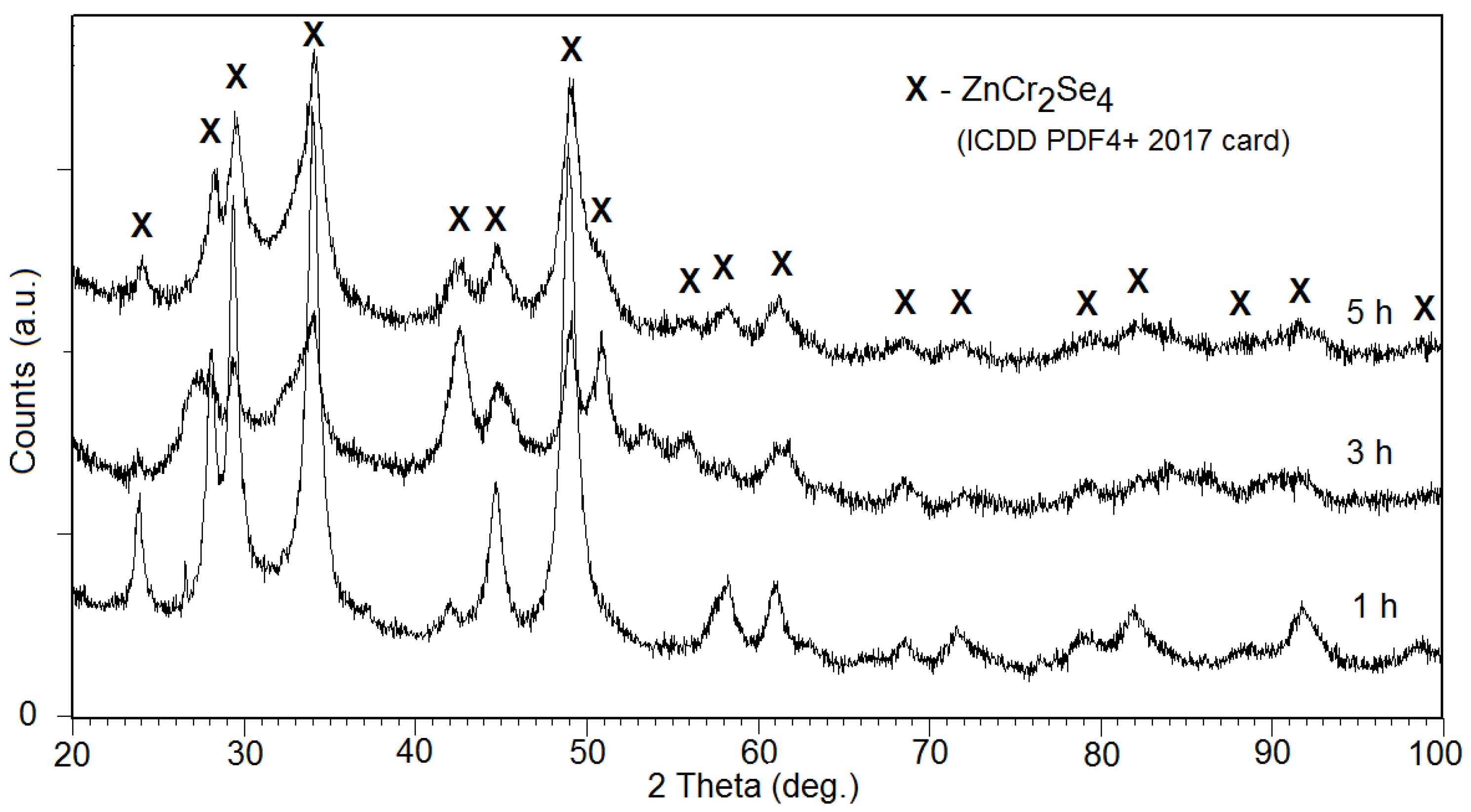
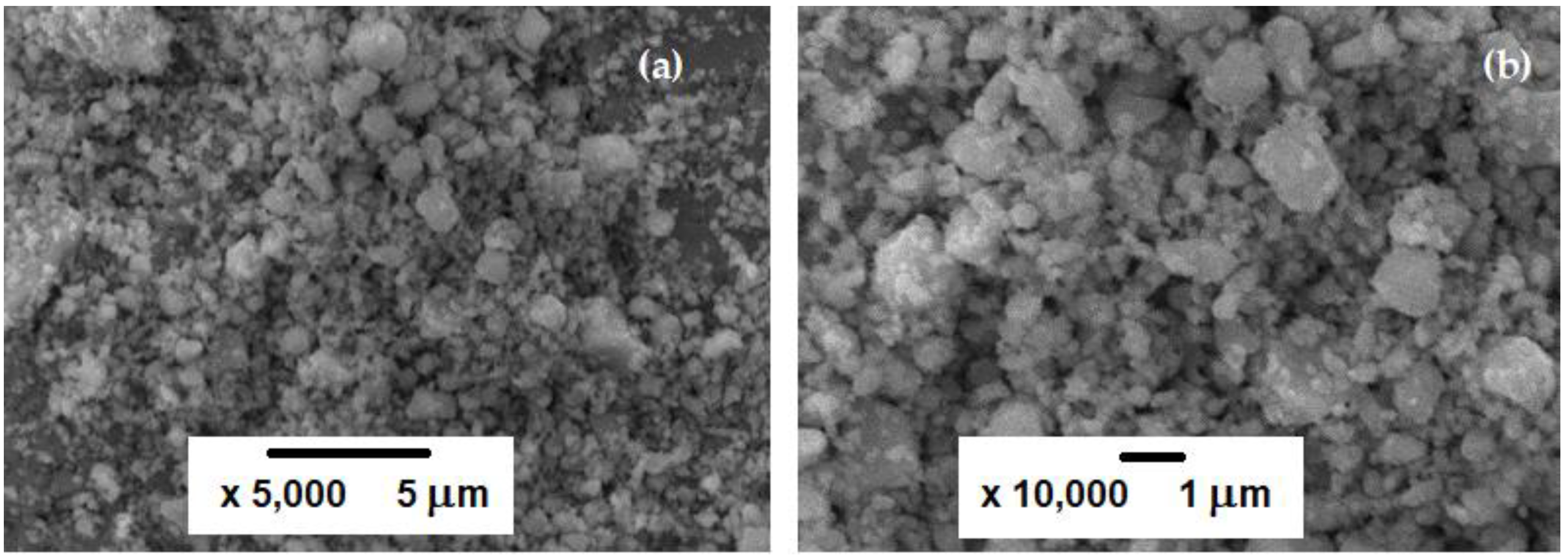
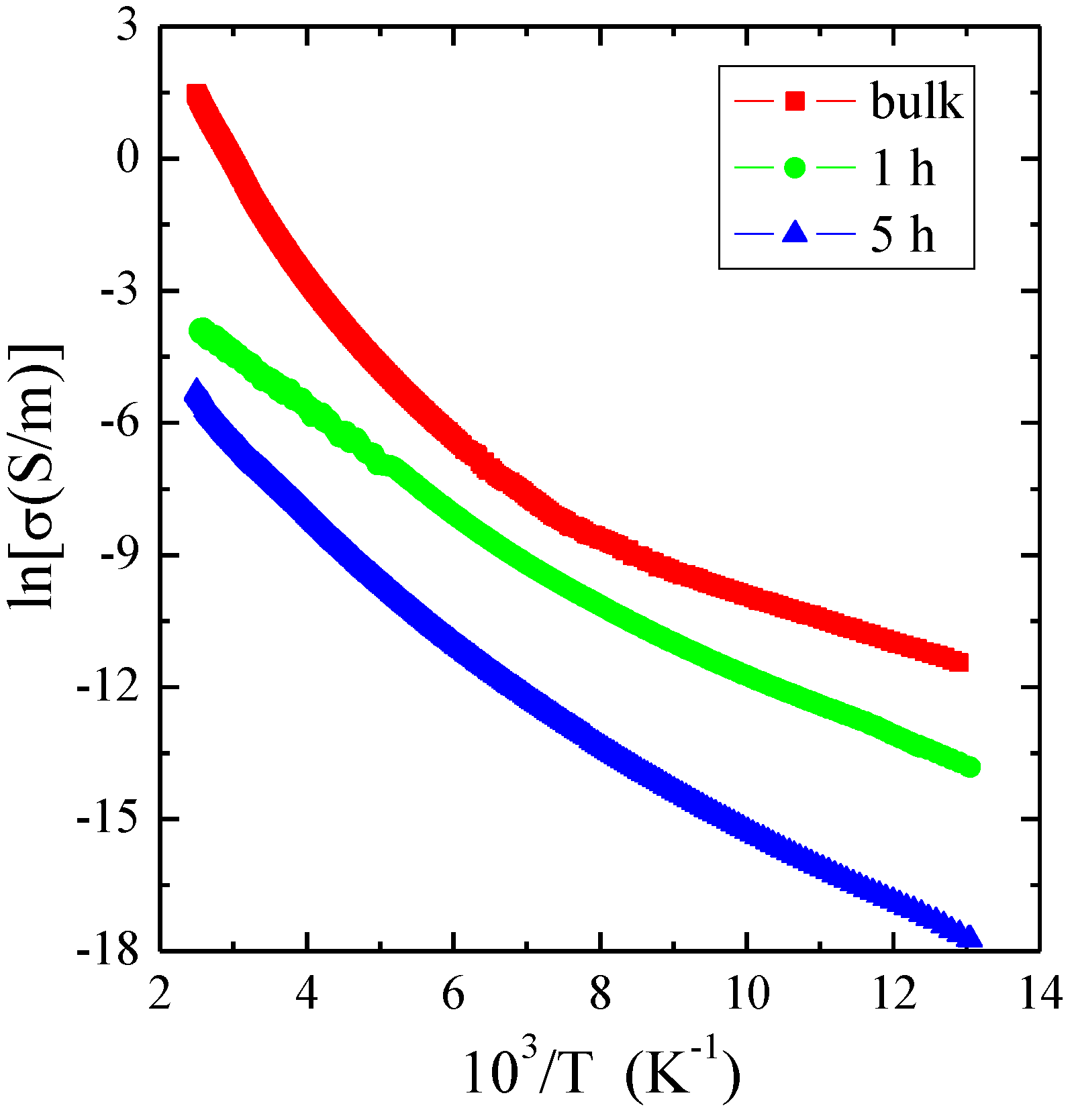
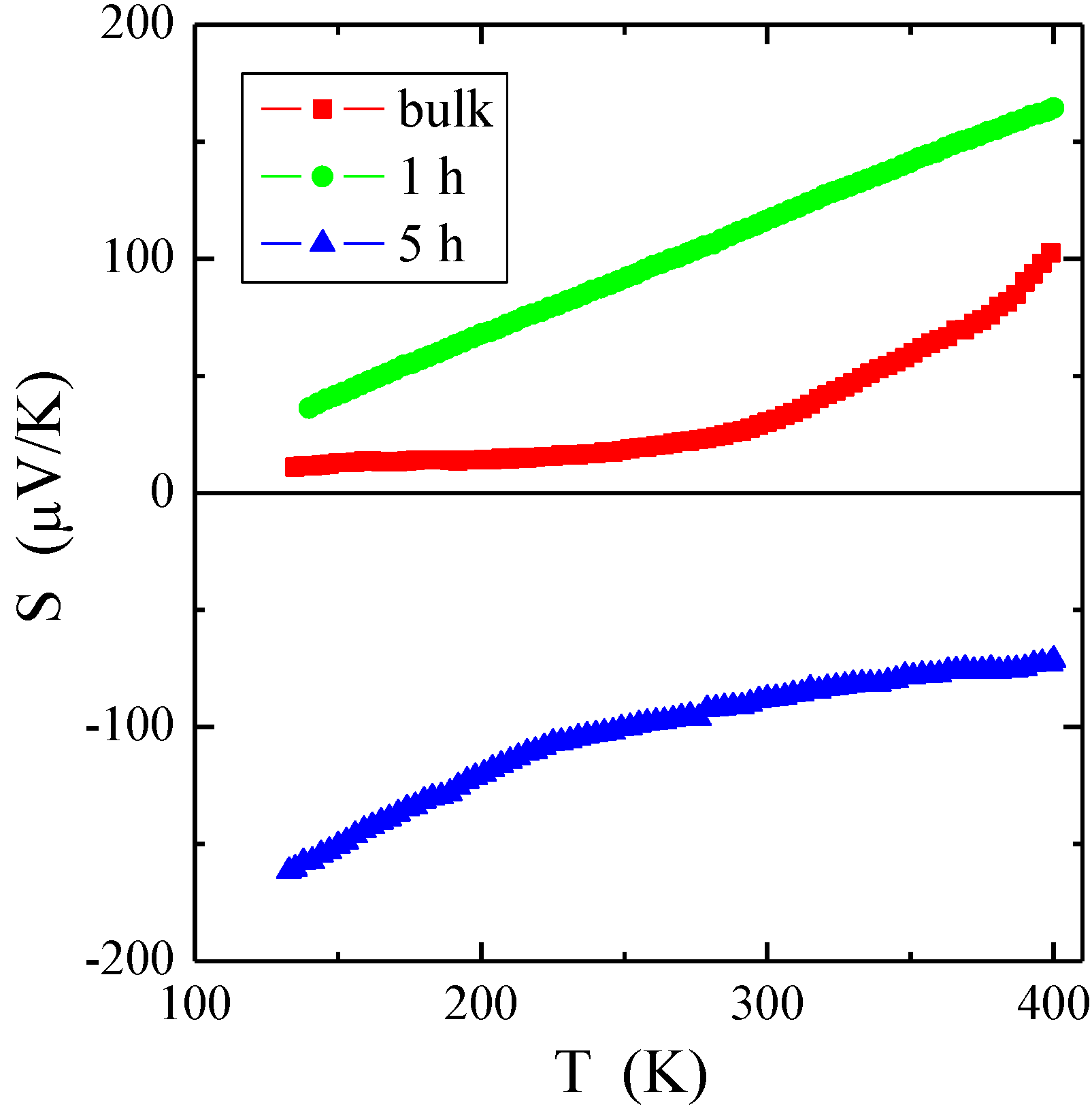
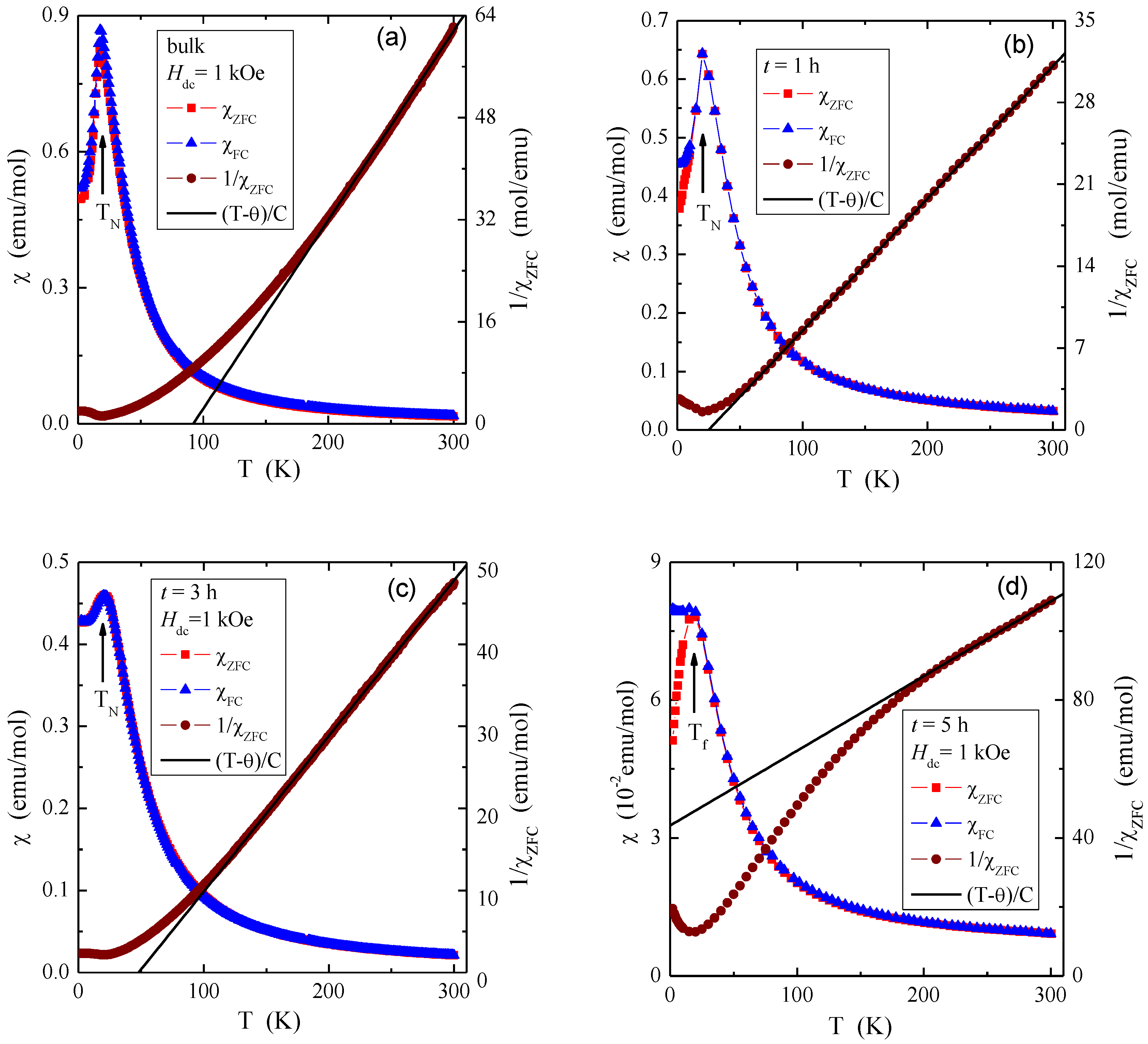
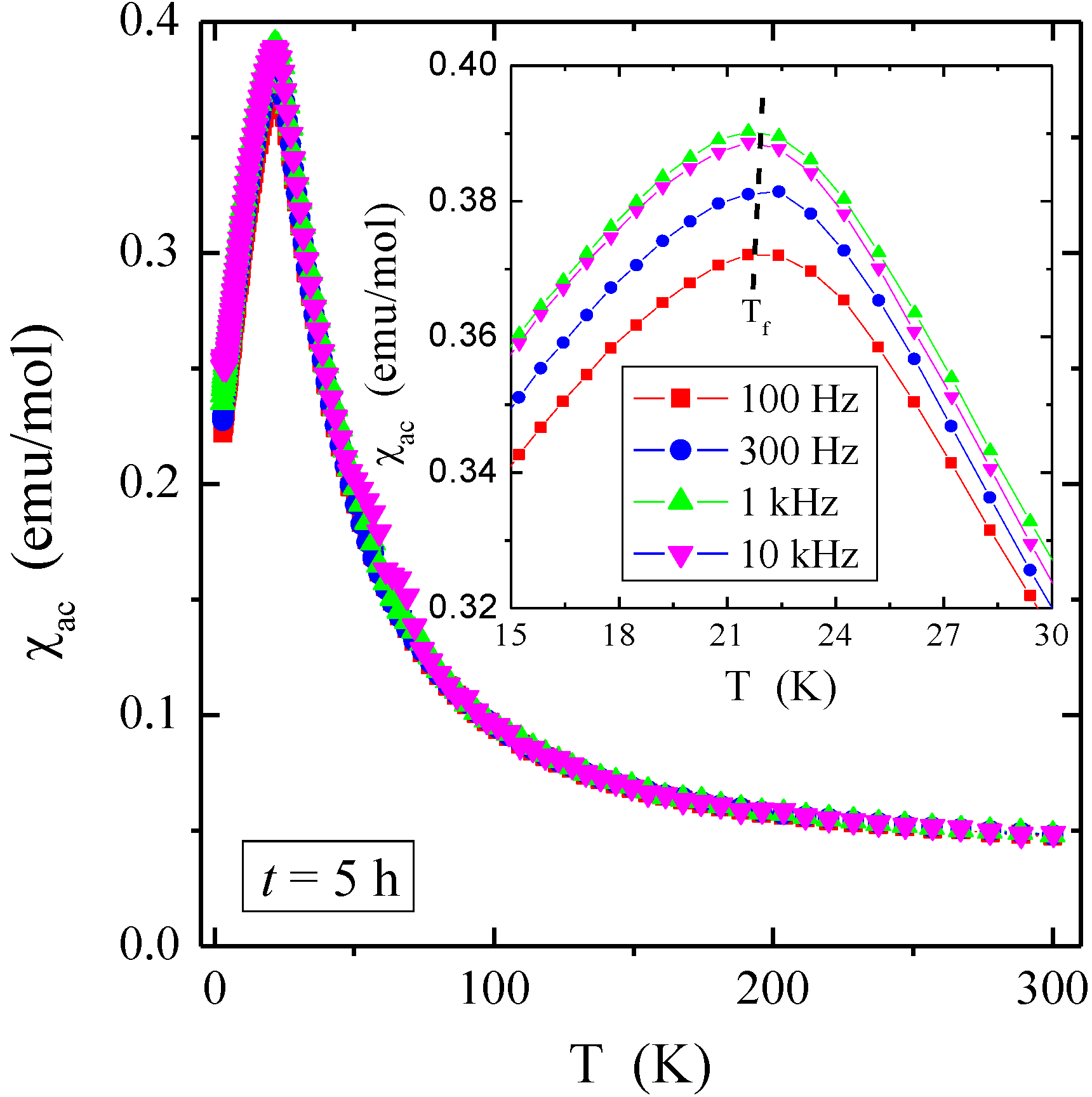
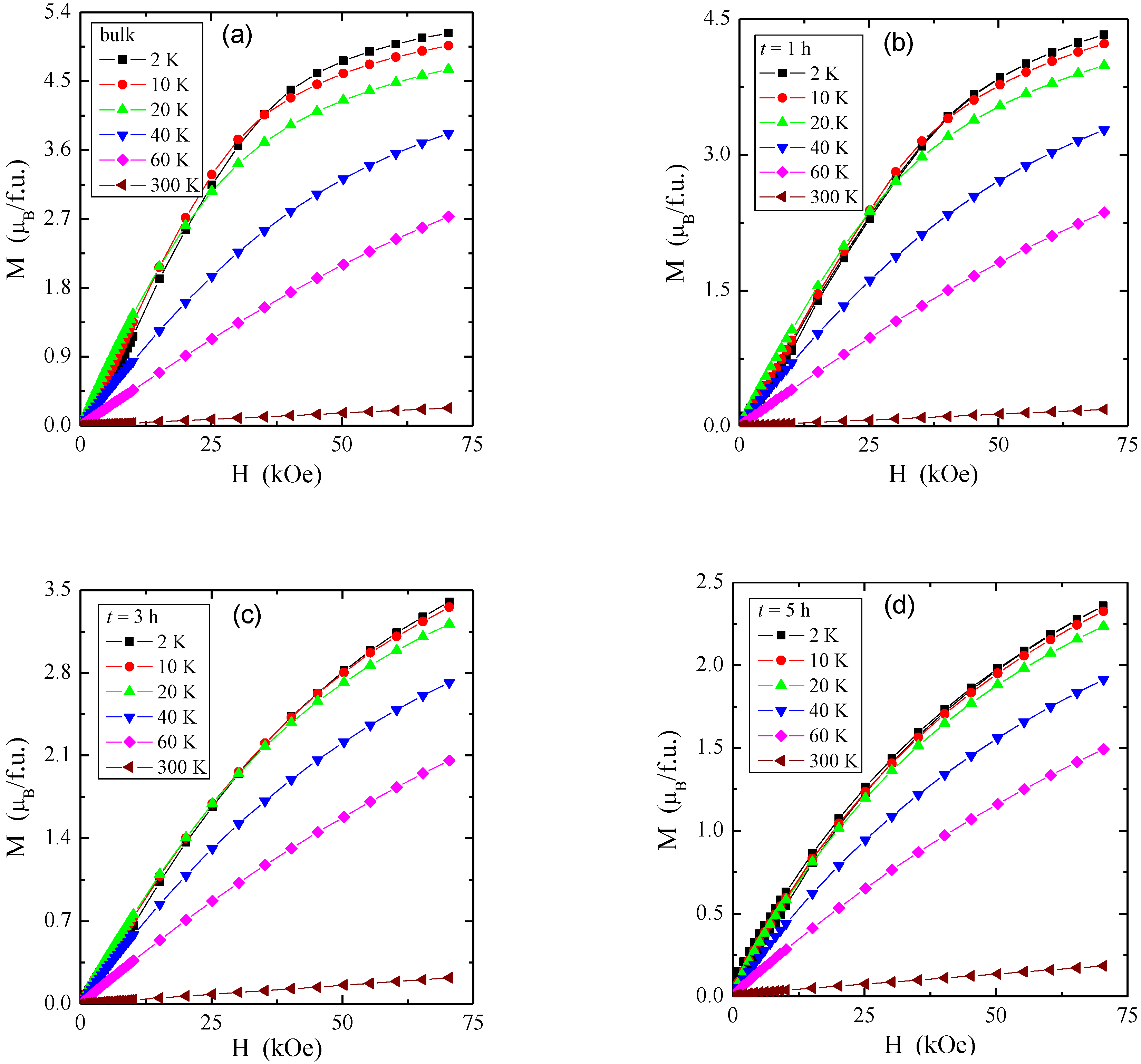
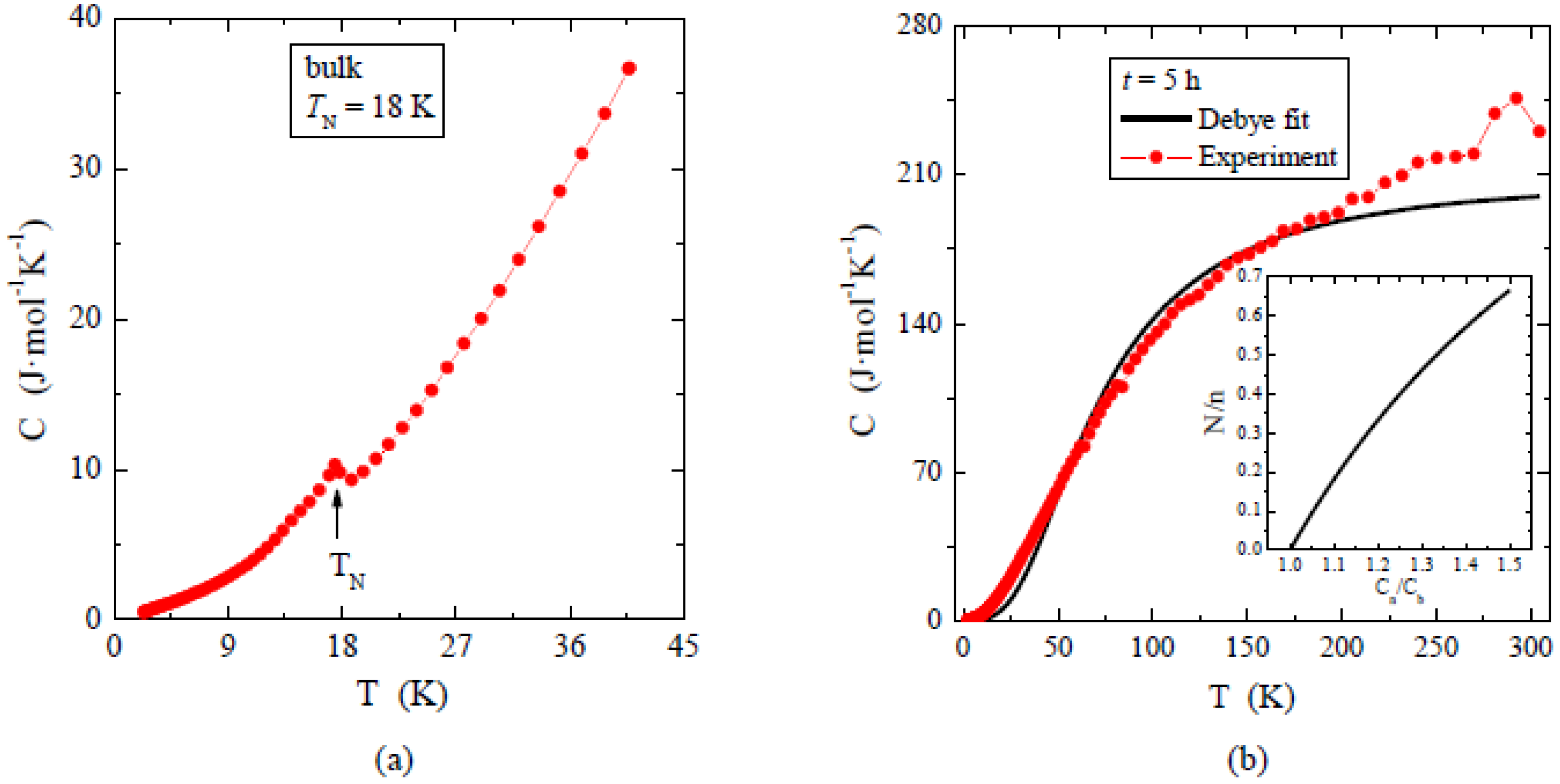
| t (h) | a (Å) | d (nm) | τ (%) |
|---|---|---|---|
| 1 | 10.5064(5) | 25.(2) | 0.8 |
| 3 | 10.4856(4) | 2.(5) | 1.1 |
| 5 | 10.4758(3) | 2.(0) | 1.3 |
| t (h) | d (nm) | C (emu⋅K/mol) | TN (K) | θ (K) | µeff (µB/f.u.) | M(2K) (µB/f.u.) | J1 (K) | J2 (K) | Ref. |
|---|---|---|---|---|---|---|---|---|---|
| - | bulk | 4.082 | 21 | 90 | 5.714 | 6.0 | −1.65 | 1.28 | [9] |
| - | bulk | 3.377 | 18 | 92 | 5.197 | 5.125 | −1.17 | 1.22 | this paper |
| 1 | 25 | 8.841 | 20 | 25 | 8.409 | 4.328 | −2.58 | 0.71 | this paper |
| 3 | 2.5 | 5.273 | 20 | 48 | 6.494 | 3.401 | −2.20 | 0.90 | this paper |
| 5 | 2 | 4.611 | Tf = 20 K | −201 | 6.073 | 2.358 | JSG = 33.3 K | this paper | |
© 2019 by the authors. Licensee MDPI, Basel, Switzerland. This article is an open access article distributed under the terms and conditions of the Creative Commons Attribution (CC BY) license (http://creativecommons.org/licenses/by/4.0/).
Share and Cite
Malicka, E.; Karolus, M.; Groń, T.; Gudwański, A.; Ślebarski, A.; Goraus, J.; Oboz, M.; Sawicki, B.; Panek, J. Influence of Crystallite Size on the Magnetic Order in Semiconducting ZnCr2Se4 Nanoparticles. Materials 2019, 12, 3947. https://doi.org/10.3390/ma12233947
Malicka E, Karolus M, Groń T, Gudwański A, Ślebarski A, Goraus J, Oboz M, Sawicki B, Panek J. Influence of Crystallite Size on the Magnetic Order in Semiconducting ZnCr2Se4 Nanoparticles. Materials. 2019; 12(23):3947. https://doi.org/10.3390/ma12233947
Chicago/Turabian StyleMalicka, Ewa, Małgorzata Karolus, Tadeusz Groń, Adrian Gudwański, Andrzej Ślebarski, Jerzy Goraus, Monika Oboz, Bogdan Sawicki, and Joanna Panek. 2019. "Influence of Crystallite Size on the Magnetic Order in Semiconducting ZnCr2Se4 Nanoparticles" Materials 12, no. 23: 3947. https://doi.org/10.3390/ma12233947
APA StyleMalicka, E., Karolus, M., Groń, T., Gudwański, A., Ślebarski, A., Goraus, J., Oboz, M., Sawicki, B., & Panek, J. (2019). Influence of Crystallite Size on the Magnetic Order in Semiconducting ZnCr2Se4 Nanoparticles. Materials, 12(23), 3947. https://doi.org/10.3390/ma12233947







